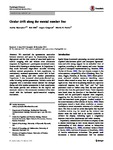Ocular drift along the mental number line.
| dc.contributor.author | Myachykov, A | |
| dc.contributor.author | Ellis, R | |
| dc.contributor.author | Cangelosi, Angelo | |
| dc.contributor.author | Fischer, MH | |
| dc.date.accessioned | 2016-03-30T08:16:05Z | |
| dc.date.accessioned | 2016-03-30T08:17:40Z | |
| dc.date.available | 2016-03-30T08:16:05Z | |
| dc.date.available | 2016-03-30T08:17:40Z | |
| dc.date.issued | 2016-01-02 | |
| dc.identifier.issn | 0340-0727 | |
| dc.identifier.issn | 1430-2772 | |
| dc.identifier.uri | http://hdl.handle.net/10026.1/4438 | |
| dc.description.abstract |
We examined the spontaneous association between numbers and space by documenting attention deployment and the time course of associated spatial-numerical mapping with and without overt oculomotor responses. In Experiment 1, participants maintained central fixation while listening to number names. In Experiment 2, they made horizontal target-direct saccades following auditory number presentation. In both experiments, we continuously measured spontaneous ocular drift in horizontal space during and after number presentation. Experiment 2 also measured visual-probe-directed saccades following number presentation. Reliable ocular drift congruent with a horizontal mental number line emerged during and after number presentation in both experiments. Our results provide new evidence for the implicit and automatic nature of the oculomotor resonance effect associated with the horizontal spatial-numerical mapping mechanism. | |
| dc.format.extent | 379-388 | |
| dc.format.medium | Print-Electronic | |
| dc.language | eng | |
| dc.language.iso | eng | |
| dc.publisher | Springer Science and Business Media LLC | |
| dc.relation.replaces | http://hdl.handle.net/10026.1/4437 | |
| dc.relation.replaces | 10026.1/4437 | |
| dc.subject | Adult | |
| dc.subject | Attention | |
| dc.subject | Auditory Perception | |
| dc.subject | Eye Movements | |
| dc.subject | Female | |
| dc.subject | Humans | |
| dc.subject | Male | |
| dc.subject | Reaction Time | |
| dc.subject | Saccades | |
| dc.subject | Vision, Ocular | |
| dc.title | Ocular drift along the mental number line. | |
| dc.type | journal-article | |
| dc.type | Article | |
| plymouth.author-url | https://www.webofscience.com/api/gateway?GWVersion=2&SrcApp=PARTNER_APP&SrcAuth=LinksAMR&KeyUT=WOS:000373997800005&DestLinkType=FullRecord&DestApp=ALL_WOS&UsrCustomerID=11bb513d99f797142bcfeffcc58ea008 | |
| plymouth.issue | 3 | |
| plymouth.volume | 80 | |
| plymouth.publication-status | Published | |
| plymouth.journal | Psychological research | |
| dc.identifier.doi | 10.1007/s00426-015-0731-4 | |
| plymouth.organisational-group | /Plymouth | |
| plymouth.organisational-group | /Plymouth/Faculty of Health | |
| plymouth.organisational-group | /Plymouth/Faculty of Science and Engineering | |
| plymouth.organisational-group | /Plymouth/Research Groups | |
| plymouth.organisational-group | /Plymouth/Research Groups/Centre for Brain, Cognition and Behaviour (CBCB) | |
| plymouth.organisational-group | /Plymouth/Research Groups/Centre for Brain, Cognition and Behaviour (CBCB)/Brain | |
| plymouth.organisational-group | /Plymouth/Research Groups/Institute of Health and Community | |
| plymouth.organisational-group | /Plymouth/Research Groups/Marine Institute | |
| dc.publisher.place | Germany | |
| dcterms.dateAccepted | 2015-11-18 | |
| dc.identifier.eissn | 1430-2772 | |
| dc.rights.embargoperiod | No embargo | |
| rioxxterms.versionofrecord | 10.1007/s00426-015-0731-4 | |
| rioxxterms.licenseref.uri | http://www.rioxx.net/licenses/all-rights-reserved | |
| rioxxterms.licenseref.startdate | 2016-01-02 | |
| rioxxterms.type | Journal Article/Review | |
| plymouth.oa-location | http://link.springer.com/article/10.1007/s00426-015-0731-4 |


